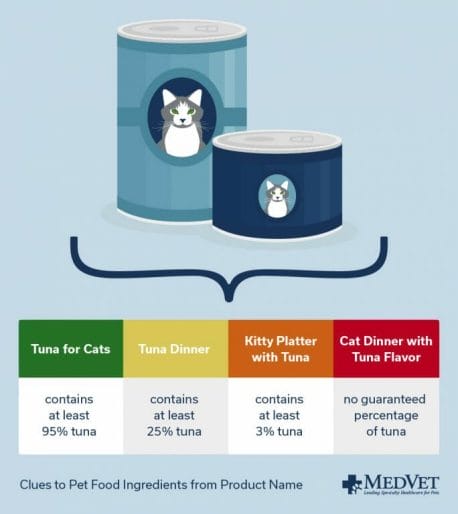
Many of us are well-versed in reading the ingredients list for the foods we eat, as well as checking labels for serving sizes, calories, and fat grams. But when is the last time you really looked at a pet food label? Can you be confident the food they’re eating is providing a complete, healthy, and balanced diet?
Pet Food Label Basics
The U.S. Food and Drug Administration (FDA) regulated pet food labeling, and many states regulate pet food as well. Regulations are often based on recommendations from The Association of American Feed Control Officials (AAFCO) for the correct nutritional content. The AAFCO sets the appropriate proportions based on 40 different nutrients that have been identified as important to pet health.
Pet food labels must contain:
- Product name
- Species the food is for
- Quantity or amount included in the package
- List of ingredients
- Caloric content
- Manufacturer information
Every label will also have a “sell by” or “best if used by” date. This helps ensure you are buying fresh food for your pet. You’ll also find feeding recommendations. Keep in mind that these are not rules but a generalized recommendation. Every pet’s nutritional needs are different based on breed, size, overall health, and activity level. Because of that, you should talk to your veterinarian about your pet’s specific nutritional and feeding needs.

Understanding Pet Food Ingredients Based on the Label
Pet food ingredients are listed in order by weight from greatest to least used in manufacturing. Each ingredient must be listed individually and cannot be combined into general terms like “grain products.” Finally, the common name must be used for ingredients. The major ingredients will be the first few listed. Minor ingredients will follow and typically are the vitamins, minerals, preservatives, coloring, and flavoring.
You may also get a clue to the product’s ingredients from the product name. Including specific ingredients in the product name is regulated by the percentage of that ingredient used to make the product.
- 95% rule: If we had a product named “Tuna for Cats,” then at least 95% of the product, not counting the water for processing, would have to be made of tuna. Vitamins and minerals that are needed for nutritional reasons make up the other 5%.
- 25% rule: If you purchased “Tuna Dinner,” it would mean less than 95% but more than 25% of the product was made from the named ingredient. There are a variety of qualifying words such as dinner, entrée, or platter that can clue you in to this.
- “With” rule: For a product named “Kitty Platter with Tuna,” it means that at least 3% of the product needs to be that named ingredient.
- Flavor rule: If we had a product named “Cat Dinner with Tuna Flavor,” then there is not a minimum percentage of meat in the product if there is enough to be detected.

Other Key Information Included on Labels
Although the ingredient list is the most important, there are a few other items that can be helpful when learning about your pet’s food.
- The Nutritional Adequacy Statement. For a pet food to say it is “complete and balanced,” it must contain the appropriate levels of nutrients that a pet would need to stay healthy eating just that food. This statement may also include information as to the life stages that the food is formulated for. For instance, puppies and kittens have different nutritional needs than an adult or senior dog or cat.
- The guaranteed analysis section tells you the minimum percentages of protein and fat, and the maximum percentages of fiber and water the food has. For products making a special nutritional claim, this section would show the minimum and maximum percentage of those items.
Looking Deeper into Other Dietary Considerations
There are other important things to consider when picking the right food for your pet. For instance, some chronic conditions require special diets. Certain foods may also trigger allergies or food intolerances in your pet. These can present as gastrointestinal issues or skin conditions. According to Veterinary Practice News, only about 10% of pets have a true food allergy, and those are often in response to a protein in the food. The only way to diagnose a food allergy correctly is with dietary adjustments that should be overseen by a veterinarian.
Some diets, like raw, vegetarian, or grain-free, have grown in popularity but may not be as healthy for your pet as some may lead you to believe. The FDA is investigating a connection between grain-free diets and the development of dilated cardiomyopathy (DCM). DCM is characterized by enlargement and decreased function of one or both ventricles. This results in worsening cardiac function and ultimately congestive heart failure. Although DCM can develop for various reasons, including genetics, recent studies have shown potential links between diet and the disease. The diets in question are collectively referred to as “BEG diets” from Boutique companies, contain Exotic ingredients, and many are labeled as Grain-free. Learn more about BEG diets and the impact it can have on your pet.
You’re Fueling Your Pet So Choose Food Carefully
Food and water are the fuel your pet needs to stay energized, hydrated, and healthy. Determining the type of food, frequency of feeding, and the amount your pet needs are all important considerations. Reading pet food labels, and knowing what information to look for, is one of the keys to choosing the correct food. Labels are regulated more than advertising and marketing around different pet foods. That makes understanding labels the best way to decipher what you’re really feeding your pet. You should also talk with your veterinarian to determine the appropriate nutritional and calorie needs for your pet along with any specific health concerns you have.